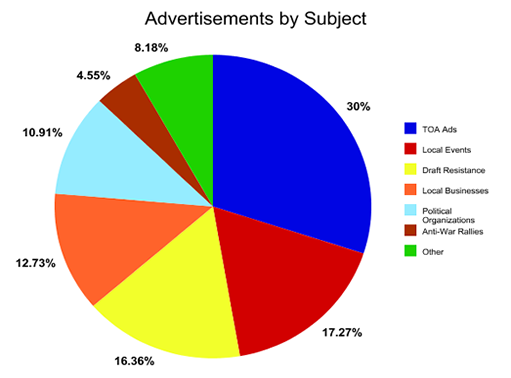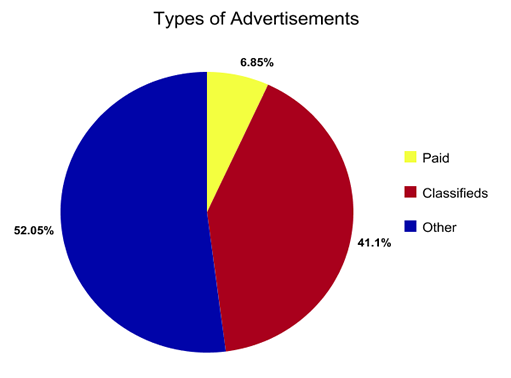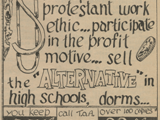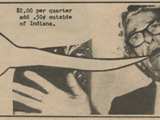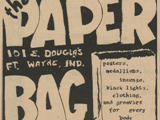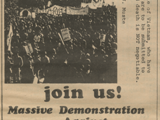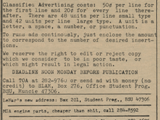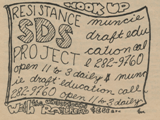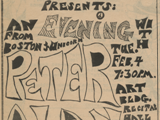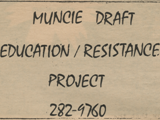Advertisements and Classifieds in The Only Alternative:
Paid advertisements and classified ads played a crucial role for many underground newspapers. With their typically small circulation numbers and low issue price, many papers relied on paid advertisements to help fund printing. While printing newspapers had become much easier and cost-effective with the invention of the mimeograph, it still cost approximately $500-$1000 per issue for many newspapers. With most papers ranging from $.25 to $.35 an issue, sales of individual issues would not typically cover the cost of running the newspaper. (Glessing, 85) This cost could be greatly offset by selling full and half-page ads to local businesses.
Like most other underground newspapers, The Only Alternative sold advertisement space. Unlike most other papers, The Only Alternative had a very small percentage of space dedicated to advertisements, much less than the 30% that Robert Glessing estimates in his study. (Glessing, 91) The full run of the newspaper contains about 129 advertisements of different kinds with approximately 15 paid advertisements and 114 unpaid. This number increases to 219 once individual classified ads are added to the total. These ads can be further broken down into several categories including draft resistance advice ads, The Only Alternative ads, local business ads, music and art show ads, classifieds, campus activity ads, and ads for political societies.
The low percentage of paid ads, about 12%, suggests that advertisements were not a large source of income for the newspaper. This confirms the October 27, 1969 Daily News interview with Carl Van Buskirk which states that most of the newspapers income comes from subscriptions and sales rather than advertisements. Paid ads cost $65 for a full-page ad and $35 for a half-page. Most of these ads were for local businesses including ads for the Neptune Nite Club, the Black Bag Shoppe, Chic’s Liquor Store, Kaleidoscope, Al’s Cardinal Inn, The Paper Bag, and a local book sale. While most of these ads were for businesses in Muncie, The Paper Bag, a store which sold posters, medallions, and incense, among other things, was located in Fort Wayne, nearly 80 miles from the headquarters of The Only Alternative in Muncie. This suggests either a wide readership of the newspaper or that this store sold items that were not readily available in Muncie at that time. Kaleidoscope and the Black Bag Shoppe were clothing stores with the Black Bag Shoppe specifically catering to African-Americans. The Neptune Nite Club, located in the downtown area of Muncie, advertised dancing and live music specifically aimed at Ball State students. These paid business advertisements give interesting insight into the local counterculture community. The graph on the left shows the advertisements broken down by category while the one on the right illustrates the advertisements broken down by paid versus unpaid.
The advertisement subjects can be broken down into seven categories: TOA ads - which includes ads asking for people to sell TOA or contribute to the newspaper, Local Events - which includes concerts and other events on the Ball State campus and the greater Muncie area, Draft Resistance - which includes hot-lines for information on how to avoid the draft, Local Businesses - which includes ads for clothing stores, hotels, and bars, Political Organizations - which includes organizations at Ball State University and the Muncie area, Anti-War Rallies - which includes ads for anti-Vietnam rallies in Chicago and Washington, D.C., and Other - which includes subjects with fewer than 3 ads each. The following gallery shows a few examples of advertisements throughout the newspaper:
In addition to selling local business ads, The Only Alternative sold space for classified ads at a rate of $.50 for the first line and $.20 for each additional line. The newspaper also offered free want ads which were placed in the same section as the classifieds. With only 90 classified ads in its entire run, the newspaper did not rely heavily on these ads for funding. This contrasts with larger papers like the Los Angeles Free Press which, according to one editor, could not survive without them. Beginning with Volume 2 Number 1 through Volume 3 Number 6, the newspaper ran 16 classified ad sections with 90 ads including personal ads, for sale ads, and want ads. In contrast to many other newspapers, none of The Only Alternative personal ads were overtly sexual in nature with most focusing more on jokes about events and people on the Ball State campus. (Glessing, 92, 103,115) Others served as personal messages to readers of the paper. The most common classified ads were for sale ads, typically offering cars, automotive parts, or musical instruments for sale. While these ads seem to be typical of classified ads in both underground and mainstream newspapers, the want ads offer an interesting difference. In several of these ads, the poster was offering himself as a nude model for art or cinema projects. Other ads include people seeking models, nude or otherwise, for different projects. While these ads are not overtly sexual, they are not the type of want ads which would have been placed in the Muncie Star Press or the Ball State Daily News. As unique chances for the readers of the paper to interact with each other, these classified ads represent a further look into this local countercultural community.
Van Buskirk also claims that The Only Alternative sold an average of 1500 copies per issue. At an average of $.25 per issue, The Only Alternative had an income of approximately $750 a month off of sales alone, though depending on the number of yearly subscriptions the true number may actually be a bit lower as yearly subscriptions cost only $1.50. While there is no record of the number of paid subscriptions for the newspaper, Glessing estimates that subscriptions made up 10 to 15 percent of the total sales of most underground newspapers. (Glessing, 90) With a sale of 1500 copies per issue, subscriptions made up an estimated 100 to 150 copies for The Only Alternative.
